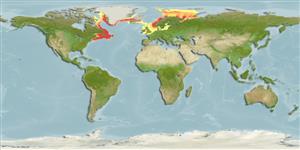Actinopterygii (ray-finned fishes) >
Perciformes (Perch-likes) >
Anarhichadidae (Wolffishes)
Etymology: Anarhichas: Greek, anarhichaomai = to climb up.
Environment / Climate / Range
Ecology
Marine; demersal; oceanodromous (Ref. 51243); depth range 25 - 600 m (Ref. 35388), usually 100 - 400 m. Temperate, preferred 2°C (Ref. 107945); 81°N - 42°N, 71°W - 59°E
Northwest Atlantic: western Greenland and Nova Scotia in Canada to Massachusetts in USA and perhaps to New Jersey, USA (Ref. 7251). Northeast Atlantic: Spitsbergen southward to Scandinavian coasts (to about Bergen, also Iceland and south-eastern coasts of Greenland.
Length at first maturity / Size / Weight / Age
Maturity: Lm ?, range 50 - 60 cm
Max length : 180 cm TL male/unsexed; (Ref. 7251); common length : 120 cm TL male/unsexed; (Ref. 4694); max. published weight: 27.9 kg (Ref. 40637)
Coloration greyish brown with many distinct spots on body and dorsal fin (Ref. 35388).
Inhabits offshore waters over soft bottoms, often with boulders, from 25-590 m, but most common from 100-400 m (Ref. 4694). Benthic (Ref. 58426). Feeds mainly on echinoderms, but also crustaceans, mollusks, fishes (Ref. 4694) and worms (Ref. 58426). In Barents sea, it reached at least 80 cm, age 9 years. Marketed fresh or as frozen fillets. Leather can be made of the skin (Ref. 35388).
Spawning happens between the months of September and January at 250 m depth. Females lay great egg bunches in nests built on the ground. The size of the eggs increases with the size of the female. Egg size 5-6 mm, larval length at hatching 21-24 mm.
Barsukov, V.V., 1986. Anarhichadidae. p. 1113-1116. In P.J.P. Whitehead, M.-L. Bauchot, J.-C. Hureau, J. Nielsen and E. Tortonese (eds.) Fishes of the North-eastern Atlantic and the Mediterranean. volume 3. UNESCO, Paris. (Ref. 4694)
IUCN Red List Status (Ref. 115185)
CITES (Ref. 94142)
Not Evaluated
Threat to humans
Harmless
Human uses
Fisheries: minor commercial; gamefish: yes
More information
ReferencesAquacultureAquaculture profileStrainsGeneticsAllele frequenciesHeritabilityDiseasesProcessingMass conversion
Tools
Special reports
Download XML
Internet sources
Estimates of some properties based on models
Phylogenetic diversity index (Ref.
82805): PD
50 = 0.5938 [Uniqueness, from 0.5 = low to 2.0 = high].
Bayesian length-weight: a=0.00339 (0.00183 - 0.00626), b=3.19 (3.02 - 3.36), in cm Total Length, based on LWR estimates for this species & (Sub)family-body (Ref.
93245).
Trophic Level (Ref.
69278): 3.6 ±0.51 se; Based on food items.
Resilience (Ref.
69278): Low, minimum population doubling time 4.5 - 14 years (K=0.06-0.13; tm=8; Fec=4,200-35,200).
Prior r = 0.25, 2 SD range = 0.15 - 0.41, log(r) = -1.39, SD log(r) = 0.25, Based on: 3 K, 2 tgen, 2 Fec records
Vulnerability (Ref.
59153): Very high vulnerability (80 of 100) .
